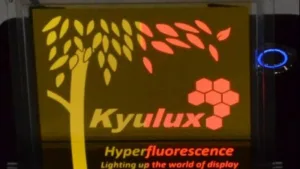During Display Week, British quantum-dot (QD) developer Nanoco and German Thermally Activated Delayed Fluorescence (TADF) developer Kyulux announced a collaboration and joint development agreement. The announcement called each of the partners a “world leader” in the development of its respective technology, although it should be noted that neither of these world leaders actually make anything in quantity.
In such situations it is natural to ask if there is obvious synergy in the collaboration, or whether it is more like the effort of two one-legged men to cling to each other and take a few more steps in an uncertain direction? Let’s see if we can find some dots to connect.
- The main differentiator for Nanoco QDs has been that they are free of heavy metals such as cadmium. Now, however, virtually all significant players are making QDs that are heavy-metal-free or have such low levels of heavy metals that RoHS rates them as safe without the need for an exemption.
- Nanoco’s long-standing agreement with Dow Chemical has produced a plant located near LG in Korea that has not produced more than sample quantities of QDs.
- Last year, Nanoco and Merck announced a licensing agreement that was to result in a Merck-built and operated plant. Both companies expressed great enthusiasm for the agreement and Merck said clearly that the agreement was on a fast track. Now, a reliable industry source informs me that no work has yet begun on the plant, and Merck has made no comment concerning where it might be built.
It is reasonable to speculate — and it is speculation — that Nanoco may have exhausted its running room and is looking for a new direction in which to run.
TADF
TADF is a technology through which the high efficiency of phosphorescent OLEDs (for which the IP is controlled by Universal Display Corp.) can be realized with certain fluorescent OLEDs. UDC has very good red, green, and yellow phosphorescent emitters so, in this arena, it would seem that the biggest potential advantage of TADF is that it can make an end run around UDC’s IP. However, UDC has not yet been able to develop a phosphorescent blue emitter suitable for full-color television. The big opportunity for TADF would be a blue emitter that combines the necessary lifetime, efficiency, color coordinates, and emission width. That full combination has not yet been demonstrated, although Kyulux competitor Cynora says it’s close. (See BC17 Cynora Progressing on TADF Blue)
But what is the synergy in combining the talents of a company that makes OLEDs (light sources) with a company that makes down-converting devices (quantum dots) that change the color of incoming light to a light of lower wavelength? Well, if you can’t make an emitter for a crucial color, you might want to use a down-converter to make the color you need. These days, you can call your friendly QD salesman and order dots to your specifications, but you might argue that working together with a QD company could produce a more optimized system.
Kyulux showed this sample in the iZone at SID
In the Innovation Zone (I-Zone) on the show floor, Kyulux showed its “hyperfluorescence” materials, the company’s name for its fourth-gen TADF. A company spokesperson said a yellow emitter will be available for customer sampling by the end of the year, with other colors to follow.
A Peel Hunt marketing communication distributed by Nanoco’s PR firm said, “The partnership will not require additional cash investment given that it will incorporate existing staff at Nanoco and Kyulux.” No new management? No new facilities? No new equipment? That’s what Peel Hunt said, presumably quoting company sources. Peel Hunt went on to say, ” The technology is likely to take 5+ years to come to market.” — Ken Werner

